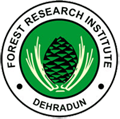
Haryana Forest Flora
A Comprehensive Database of Ligneous Plants of Haryana (India)
Designed & Developed by Bioinformatics Centre,Forest Research Institute, Dehradun



| Family: Moringaceae | Genus: Moringa | Species: Moringa oleifera Lam. ( सहजन ) |
Habit |
Leaf |
Flower |
Fruit |
Bark |
| Synonym | Guilandina moringa Linn., Moringa zeylanica Burmann | Flower Color | White |
| Common Name | Sunara, Sainjna, Shigra-tryam | Flower Type | Panicle |
| English / Trade Name | Drumstick Tree, The Horse-Radish Tree, Ben Oil Tree | Flowering Period | Jan-March |
| Vernacular /Local Name | Sainjna | Fruiting Period | April-June |
| Altitude | Upto 2000 m | Fruit Type | Capsule |
| Habit | Tree | Fruit Details | An elongate, torulose capsule, angled, longitudinally 3-valved; seeds many, 3 angled, 3 winged. |
| Habitat | Common; along miscellaneous forests of sub Himalayan tracts, often associated with Sal and Khair forests, or nearby crop fields. | Bark Type | Fissured |
| Distribution | Cultivated throughout warmer parts of India and moist tropical countries. | Bark Details | Bark corky grey, exuding yellowish-white gum.Young shoots have purplish or greenish-white, hairy bark. |
| Distribution in Haryana | Ambala, Bhiwani, Faridabad, Fatehabad, Gurgaon, Hisar, Jhajjar, Jind, Kaithal, Karnal, Kurukshetra, M. Garh, Mewat, Morni-Pinjore, Palwal, Panipat, Rewari, Rohtak, Sirsa, Sonepat, Yamuna Nagar | Origin | Native |
| Leaf Type | Compound | ||
| Leaf Arrangement | Alternate (leaves born singly along stem) | ||
| Leaf Shape | Pinnate | ||
| Description of Species | Deciduous trees, with corky bark. Leaves usually 3-pinnate, 45-90 cm long; petioles sheathing at the base; leaflets about 6-10 pairs, opposite, central ones largest, one or more conspicuous glands at the junction of pinnules, pinnae and rachis; leaflets elliptic, ovate-obovate, 1-2.5 cm long. Flowers pedicelled, about 2.5 cm across, white or pinkish, honey scented, in large compound, spreading, 30-60 cm long panicles; bracts linear. Calyx cup-shaped. Petals 5, unequal, narrowly spathulate. Stamens 5 fertile, 5 staminodes. Ovary stipitate, 1-celled, hairy; seeds trigonous, winged at the angles. | Leaf Details | Leaves usually 3-pinnate, 45-90 cm long; petioles sheathing at the base; leaflets about 6-10 pairs, opposite, central ones largest, one or more conspicuous glands at the junction of pinnules, pinnae and rachis; leaflets elliptic, ovate-obovate, 1-2.5 cm long. |
All rights reserved by Forest Research Institute, Dehradun
The contents of this website may not be reproduced partially or fully, without due permission from The Director, Forest Research Institute, Dehradun -248006 (Uttarakhand), If referred to as a part of another publication, the source must be appropriately acknowledged. No part of this web-portal i.e. source code, any picture, image, graphics, text, design may copy or reproduce in any form of publication / software / web application development / creation. The contents of this website can not be used in any misleading or objectionable context. The Copyright Act 1957 and Copyright (Amendment) Act, 2012, Govt. of India will be applicable for any dispute.